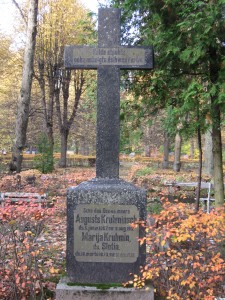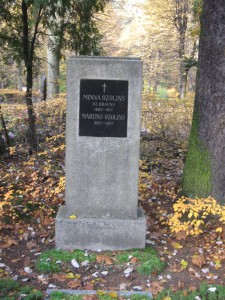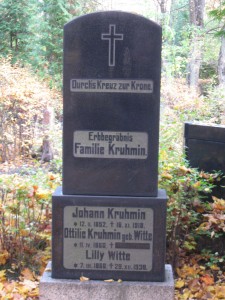This is part of my series of interesting newspaper articles that I find in the old Latvian newspapers available through Periodika. Most of the articles I post are in some way related to migration, wars or other events that are of particular genealogical note.
New Surname, by Andris Bērziņš
“It is difficult to say how many citizens we have with non-Latvian or unpleasant surnames”, says the director of the passport section of the Ministry of Internal Affairs. “Based on our observations thus far, their count could be in the hundreds of thousands.”
These hundreds of thousands of people are now being moved to make use of the new surname change law.
Who is requesting a new surname? Firstly, they are Latvians, who do not know how they ended up with surnames such as SeskoviÄs, Hofmanis, BoÄka and other similar surnames. Therefore, they would like to get rid of them, so that in a few weeks they could be known as Sarma [NB: hoarfrost], Dzelme [NB: depth] or Atvars [NB: whirlpool]. The same could be said about those who have unpleasant surnames. There are many of them as well, and they may be the happiest about the ability to change their surnames. And why not? For example, how does a young and handsome fellow feel, if he has to bear the surname TÄ“viņš [NB: buck, cockerel, could also mean old man] because of the whim or presumption of someone in the past? Someone involved in the temperance movement would feel even worse if they look in their passport and the name they have is Å nabovics [NB: Slavic patronymic-style derivation of “Å¡nabis” meaning “alcohol”]. Someone with the surname PÅ«slis [NB: bladder] would not put down others with the surnames Muļķis [NB: fool], Å mucis [NB: mess] or similar surnames. So it is no surprise that these people have gotten rid of their unpleasant surnames, and they feel quite happy.
But the surname change movement has also made other people nervous. These are citizens with clearly Latvian surnames, that are, to them, considered too simple.
“The worst thing is is that these people are not given an opportunity to explain themselves,” says a police official. “For example, someone with the name ZaÄ·is [NB: Rabbit] comes in and asks to change their surname. When he is told that ZaÄ·is is a perfectly nice Latvian surname, he responds ‘The surname wouldn’t be bad if it weren’t for the fact that because of it I become the butt of jokes. For example, anyone can tell me, ‘he’s as scared as a rabbit!’ and I don’t like that.'” But then other citizens with non-Latvian surnames show up and ask if they could have their surnames changed to that same ZaÄ·is. It also happens that people have surnames that are connected to their professions. Another police official says: “A man arrived to speak to me and told me: ‘My name is Gailis [NB: Rooster] and I want to change my surname.’ – But why? It is good. – ‘No no. My profession requires me to speak before vast auditoriums of people. If someone in the corner of the room calls out – Why is he there singing like a rooster? – then my career is over.'”
The Passport section of the Ministry of Internal Affairs has also encountered people who do not properly understand their surnames. They are predominantly simple people. After it is explained to them that Daija, MurjÄnis and NorÄ«tis are perfectly pleasant Latvian names, they are satisfied and say thank you and head home. In general, it can be said that people are striving to choose familiar and pleasant-sounding names. In the space of just a few months, names such as Krauja, Dzelme, Sarma, Veldre and other similar names have been restricted because they are in such high demand.
How do citizens who have Latvianized their surnames feel? “It has been two weeks since I changed my name, but I’m still not completely used to it,” says one ministry official. “And how else could it be, because I lived with it for most of my life.”
Other people with new surnames feel the same way. Asking them, one after another will mention an interesting episode.
“After the announcement in the ‘Governmental Herald’, I knew that starting the next day I would be known by my new surname,” says a higher government official, who has to sign a lot of documents each day. “Arriving at work, I was only thinking about my new surname. But as soon as the work rush started and a clerk came in with a pile of papers to sign, I had forgotten my new surname and was writing the old one on all of the papers. Of course, the documents needed to be done all over again. Now I am used to the change.”
“I feel great after getting my new surname,” says one office clerk. “Only the first week was a bit difficult, ‘adjusting my hand to a new speed’, so to speak, so that I would learn how to sign the new surname well, which was one and a half times shorter than the old one. Until I found the best way to sign it, I had worked almost as much as I would be working in the forest.” An associate, who didn’t have to change his surname, saw a friend on the street, who had just changed his surname, and called out to him, “Agrum, Agrum!”, to stop his friend, but the friend just went along by. “I called out his new surname a few more times, but he didn’t pay any attention!” he says. “Then I called: GÅ«tman, are you deaf! – My friend spun around quickly – he could still hear his old surname.”
New surnames have also caused confusion in telephone conversations, which one minister’s secretary described. A clerk had called him, already knowing his new surname, and then asked “Could I please speak with Mr. X?” – “There is no one here by that name.” the secretary replied. “What number do you need?” “I want to talk to the secretary.” said the confused caller. “I’m at the phone.” the secretary replied, only then remembering that the name the caller had asked for was his new surname.
These changes have also created merriment in private social gatherings. A man arrived to one function, having just changed his surname. When other guests arrived, he forgot his new surname and introduced himself with the old surname. Only after a moment did he realize his mistake, and had to reintroduce himself to the guests, saying “I’m sorry, there was a bit of a misunderstanding – now I am called by a different name.”
When hearing all of these amusing anecdotes, women just smile and shake their heads, since for them changing surnames is not unusual. Almost every woman, unless she remains a spinster, will change her surname at least once, some even two or three times. When one woman was asked, how her family felt after she changed her non-Latvian name, she just smiled and responded: “If the same husband hadn’t been by my side at the time, they would have just thought that I’d married a second time.”
I think this is an amusing collection of anecdotes on the surname change process, which I talked about in more detail here and here. Getting used to a new surname, especially after having one for decades, could not be easy. But only at the end of the article did the writer remember that almost half of the population would change their name at some point in their lives – reminding readers that the world does not revolve solely around men.



